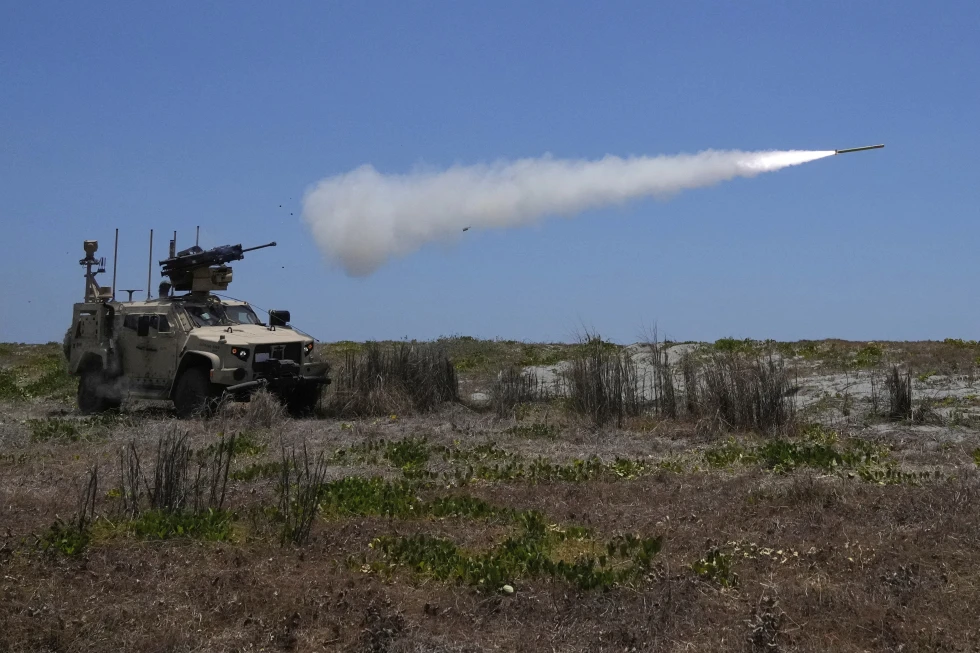
The U.S. military has deployed an anti-ship missile launcher for the first time on Batan Island in the Philippines, as Marines unloaded the high-precision weapon on the northern tip of the archipelago, just a sea border away from Taiwan.
U.S. and Philippine forces separately unleashed a barrage of missile and artillery fire that shot down several drones acting as hostile aircraft in live-fire drills on Sunday in Zambales province facing the disputed South China Sea.
The mock battle scenarios over the weekend in the annual Balikatan exercises between the U.S. and its oldest treaty ally in Asia, the Philippines, not only simulated real-life war. They were also staged near major geopolitical hotspots, which have become delicate frontlines in the regional rivalry between China and the U.S. under former President Joe Biden and now Donald Trump.
About 9,000 American and 5,000 Filipino military personnel took part in the combat maneuvers. At least 260 Australian personnel also joined, with smaller observer delegations from Japan and other countries.
China has fiercely opposed the combat drills as provocative. Its aircraft carrier group sailed by a few days earlier near Batanes, where the U.S. military had deployed the Navy Marine Expeditionary Ship Interdiction System on Saturday on Batan near the Bashi Channel just south of Taiwan, a critical trade and military route that the U.S. and Chinese militaries have tried to gain strategic control of.
“The introduction of NMESIS into the first island chain for sea denial, sea control is another step in our force design journey,” U.S. Marine Lt. Gen. Michael Cederholm told a small group of journalists, including from The Associated Press, who were invited to witness the transport of the missile system aboard a C-130 Air Force aircraft to Batanes.
“We’re not here practicing a war plan,” said Cederholm. “We’re practicing for the defense of the Philippines.”
The U.S. and the Philippines have denied the annual combat maneuvers — which both said would focus on a “full-scale battle scenario” this year — were aimed at China or any adversary. The lines between what’s mock and real, however, have been at times murky.
Asked if U.S. forces would pull out the anti-ship missile system from Batanes after the combat drills, Cederholm did not reply clearly.
“We don’t broadcast when we’re going in, when we’re coming out and how long things are going to stay,” Cederholm said. “All I’ll say is we’re here at the invitation and with the support of the Philippine government.”
“But I’m glad it’s here,” he said.
Additionally, China had repeatedly expressed its strong opposition to the U.S. Army deployment last year of a mid-range missile system in the Philippines for joint exercises.
The U.S. Army launcher with at least 16 Standard Missile-6 and the Tomahawk Land Attack Missiles was repositioned in January from an international airport in northern Laoag city to a northwestern coastal area facing the Scarborough Shoal, where China’s forces have used water cannons and dangerous blocking maneuvers against Philippine coast guard and fishery ships and fired flares near Manila’s patrol planes, a Philippine official then told The AP.
The official spoke on condition of anonymity due to a lack of authority to discuss the delicate issue publicly.
Tomahawk missiles can travel over 1,000 miles (1,600 kilometers), which places China within their target range.
During the combat exercises from April 21 to May 9, American and Filipino forces will also practice jointly defending Philippine islands by repelling hostile forces attempting to assault from the sea in the western Philippine province of Palawan, which faces the South China Sea, and in northern Cagayan province near Batanes.
Philippine Brig. Gen. Michael Logico said the combat exercises were crucial to strengthening deterrence against aggression in the Bashi Channel.
“A peaceful region can only be maintained through a proper balance of strength between opposing forces until such time that … both countries decide that it’s not going to be worth it to fight over this area,” Logico said.
Early this month, the Chinese military staged largescale drills in the waters around Taiwan and renewed a warning to the self-ruled democracy not to seek independence. Chinese navy, air, ground and rocket forces staged the drills.
The Philippines used to host two of the largest U.S. Navy and Air Force bases outside the American mainland. The bases were shut down in the early 1990s after the Philippine Senate rejected an extension, but American forces returned for large-scale combat exercises with Filipino troops under a 1999 agreement.
Cederholm cited the tens of thousands of U.S. military personnel, along with Filipino scouts, buried in the vast American cemetery in Manila as proof of Washington’s commitment to help defend the Philippines beyond the U.S. bases era in the Philippines.
“We take our treaty obligations very seriously,” Cederholm said.